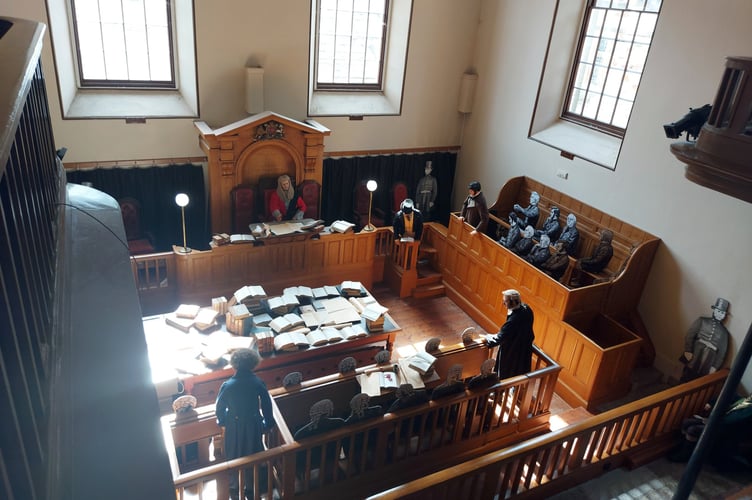IF a wall could talk, most would have some conversation.
However, if the walls of an ancient 18th century prison in Bodmin could communicate, they wouldn’t talk, they would scream so deafeningly that probably only black cats could hear them.
For within the walls of Bodmin Jail contained some of the region’s most notorious felons and criminals, condemned to an eternity of damnation for the unspeakable crimes committed on their fellow kind. Or stealing a sheep, which was a big thing back then.
It is often said that the ghosts of the occupants are often found at the former jail, which became a relic after closure in 1927 until its restoration as a luxury hotel and tourist attraction in recent years.
In the 1930s, it reopened as a casino, nightclub, and venue for mock executions, quickly becoming a popular spot for revellers and gamblers. However, after a section of the roof was removed for repairs, the structure fell into disrepair.
Attempts to demolish the building for salvage failed because the walls were so thick, over a metre in some places, that demolition was impossible. In recent years, the former Governor’s Hall has been transformed into a restaurant and event space, while other areas of the jail have turned into a tourist attraction, particularly appealing to those interested in the paranormal.
With the Victorian times also being a time before daytime light entertainment, quiz shows and even Coronation Street, witnessing the final moments of felons as they were hanged to death were also popular with one execution of two brothers attracting trainloads of witnesses to Bodmin Jail.
It was reported that some had to remain on coaches at the overcrowded Bodmin North railway station, such was the demand to see them die.
Here are some of the stories of the jails more notorious inmates.

Elizabeth Osborne: The sacked firestarter
Elizabeth Osborne, feeling scorned and seeking revenge against her former employer, John Lobb, set fire to his corn mow on May 28, 1813, three years after her dismissal. Reports indicate she showed no remorse for her actions, proudly sharing details of her crime with others.
While arson is now seen as a lesser offence, it was considered a capital felony in 1813, as a serious fire could have dire consequences for property owners. On August 16, 1813, Osborne was sentenced to death, a verdict complicated by a halt in US grain imports due to the War of 1812-15. Her execution took place on September 6, 1813, drawing a large crowd of spectators.
Joan Wytte: The witch in the walls
Joan Wytte, the Fighting Fairy Woman of Bodmin, was a local witch incarcerated in Bodmin Jail for brawling. After her death in 1813 inside the jail from pneumonia, her bones were used in seances during the Victorian era, then displayed in a glass coffin in the Museum of Witchcraft until she was finally laid to rest in Boscastle.
Sarah Polgrean: Murdered her abusive husband
Convicted on August 10, 1820, and executed two days later, Sarah Polgrean murdered her husband. Her crime stemmed from an unhappy marriage and a troubled past of vagrancy after being abandoned by her parents. On July 15, 1820, she visited an apothecary in Penzance to buy arsenic, claiming it was intended for killing rats. In reality, she mixed the poison with butter and spread it on her husband Henry’s bread, leading to his death. In addition to her execution, the judge sentenced her to dissection to aid medical science.

The Lightfoot Brothers: The highwaymen
With the prospect of earning more money, James and William Lightfoot turned to highway robbery. On April 13, 1840, the execution of the Lightfoot brothers drew a crowd of over 25,000. They were sentenced to death in a double execution for murdering Nevell Norway, a local merchant, by beating him with a pistol and a stick, resulting in multiple fatal injuries. During the trial, the duo tried to blame each other.
The public's demand for the execution was so intense that 1,100 passengers on a nearby train stopped to witness the event.
Selina Wadge: Murderer of children
While some crimes have seen a shift in severity over the years, the murder of a child remains a grave offence. Selina Wadge was executed in 1877 for killing her child, making her one of only four women hanged for this crime between 1868 and 1899. An unmarried mother of two illegitimate sons, one of whom was partially disabled, Wadge was among the lowest in the Victorian social hierarchy.
She claimed to be involved with a former soldier named James Westwood and travelled with her children to Launceston, supposedly to meet him. However, she returned to the workhouse with only her older son, John. Initially, Wadge claimed that Westwood had taken her younger son, Harry, and drowned him, but her story unravelled when John revealed the truth to the workhouse nurses. A police search led to Harry's body being discovered in a well. Wadge later confessed, claiming Westwood had pressured her into the murder in exchange for marriage, a statement he denied. During her trial in July 1878, the jury took just 45 minutes to find her guilty.
Despite a recommendation for mercy based on her past care for her children, Justice Denman sentenced her to death. Wadge's execution was the first private one at Bodmin Jail, and her last words were, “Lord deliver me from this miserable world.”

Matthew Weeks: The murder of Charlotte Dymond
Matthew Weeks was imprisoned for only ten days before his execution, convicted of one of the most infamous crimes in Victorian Cornwall. On April 14, 1844, the body of 18-year-old Charlotte Dymond, a domestic servant, was found on Bodmin Moor, causing a scandal in the rural community.
Weeks was suspected of being the spurned lover, as Dymond had attracted another suitor, Thomas Prout, the nephew of her employer. After Dymond went missing, suspicion fell on Weeks, who returned home with a torn shirt and muddy trousers, claiming Dymond had gone to Blisland for work. A week later, her body was discovered with a deep throat wound. After initially fleeing to Plymouth, Weeks was arrested and pleaded not guilty, but the jury found him guilty, sentencing him to hang.
He was executed on August 12, 1844, in front of a crowd of several thousand and buried in the prison’s coal yard. While the community was convinced of his guilt, some later questioned the verdict, suggesting the murder may have been a suicide and that Weeks's supposed confession was coerced due to his illiteracy.
Until recently, visitors could attend a mock trial experience at Bodmin's Shire Hall, where they could reenact the trial and decide his fate for themselves.
William Hampton: Last man hanging
The murder of Emily Tredrea sent shockwaves through Cornwall. William Hampton, her "boyfriend," confessed to the crime, though doubts about his guilt persist to this day.
Prior to his execution, a petition with over 3,000 signatures was submitted to change his sentence, but it was rejected.
On July 20, 1909, at 8am, William was led to the gallows, marking him as the last person executed in Cornwall.

Executions at Bodmin Jail
With 55 executions occurring within the confines of Bodmin Jail, it’s no surprise that many believe the walls are steeped in paranormal activity. Prior to the jail’s establishment, executions were carried out at Bodmin Common, on the outskirts of town. It wasn’t until 1802 that executions began at the jail itself, using drop gallows set up in the field outside the front entrance.
Early executions often resembled torture rather than the swift deaths many associate with capital punishment. Between 1834 and 1856, a method known as the "standard drop" or "short drop" was employed, resulting in a slow and agonizing death by strangulation, as it failed to break the condemned’s neck.
Initially, the drop site was deemed illegal by the Inspector of Prisons because the hangings were not sufficiently public. Since the main gate faced northeast, it was not visible to onlookers. Consequently, the drop was relocated to the South Wall, allowing larger crowds to witness the executions from nearby Asylum Hill.
In 1868, laws changed, mandating that all executions be conducted in private, ending the public spectacle. Later reforms introduced a more humane method, the "long drop," which ensured the prisoner’s neck would break instantly, leading to unconsciousness and death by asphyxiation. This method was pioneered by William Marwood.
New gallows were built in 1897, and an execution pit was created within an execution shed. This pit still exists today and is part of the attraction, having been restored after its discovery during renovation work in 2005.




